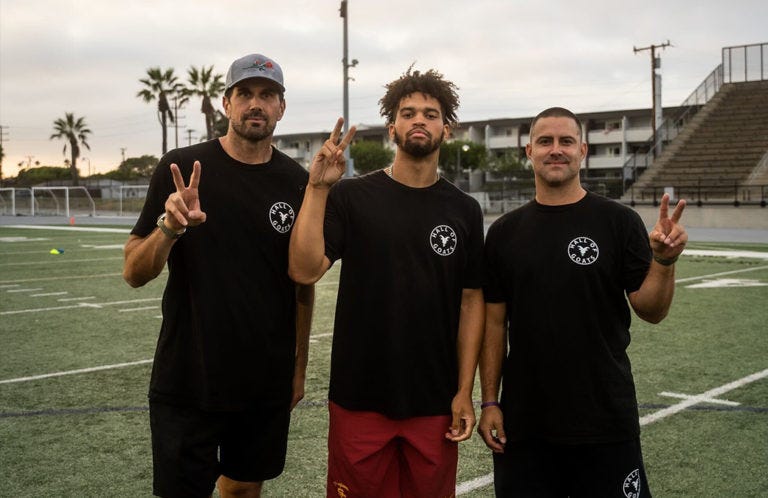This game aims to make student athletes money
Heisman Trophy winner Caleb Williams and 2004 winner Matt Leinart are joining forces to tackle the name, image, and likeness landscape with a new video game venture.

College athletes have been dunking, deking, and hitting dingers in video games since the early 1990s. But they haven't been allowed to directly profit from it until 2021.
A new venture hopes to change that. And it’s powered by—surprise!— a leading college athlete.
Heisman Trophy winner Caleb Williams of the University of Southern California has teamed up with 2004 Heisman winner Matt Leinart and his former USC teammate Greig Carlson to create the video game company, Hall of GOATS. The company seeks to introduce a blend of current and former college football stars with video games, NFTs, and a plan to provide them a share of their gaming success.
It’s now possible thanks to legislation passed in 2019 in California called the Fair Pay to Play Act, followed two years later by the Supreme Court which ruled unanimously that the NCAA can't limit the education-related benefits that colleges can offer their student-athletes.

When this Supreme Court decision allowed college athletes to monetize their name, image and likeness (NIL), Carlson, who became a software developer after graduating from USC, got ahold of his former signal caller Leinart and began working on Hall of GOATS—”GOAT” being the widely-used acronym meaning “greatest of all time.”
“I was part of a great USC run when Matt and Reggie [Bush] and a bunch of other guys really should have been compensated for what they were doing at USC and that wasn’t the case,” Carlson says. “But now that the landscape has changed, I thought this idea was fantastic. I called Leinart and told him what I wanted to do. He said, ‘Dude, I love it, I’m in, let’s do it.’ ”
“Hall of GOATS is a video game built on a blockchain that will help service and help monetize the NIL for amateur athletes, high school, college, and so forth,” describes Leinart, who is now a college football studio host for Fox Sports.
“Think like an arcade-style video game where you can use your favorite player and you can level him up,” Leinart adds. “He has a rating of five; you can spend money to level him to 99, whatever you want to do. There are different ways within the video game we can help these athletes monetize the use of their NIL. Our point of view is kind of like, one, kids love video games; two, we want to build a fricking fun video game where we can help these kids make money, period, and it’s as simple as that.”
According to Leinart, the game will feature “big hits, dancing, just kind of a fun, kind of a new-age game.” Rather than 11-on-11 like traditional football games, GOATS will feature 7-on-7 play with no rules, meaning players don’t get penalties and can taunt.
Their aim is to launch a beta version in 18 months and a full rollout in two years. To keep interest fresh, Hall of GOATS released a trailer in November to give gamers a taste of what’s to come.
The game will be free to play, with gamers able to acquire players in the marketplace. Hall of GOATS has signed about 25 current and former football stars, including former Texas quarterback Vince Young—which is ironic because Young’s Texas Longhorns beat USC in the Rose Bowl for the national championship on Jan. 1, 2006, the last college game for Leinart, Carlson, and Young.
But where Hall of GOATS’ true impact will be felt is in how it gives college athletes a share of how well they do within the video game. Athletes will receive 60% of the sales of their NFT and a 5% royalty in perpetuity on all secondary sales.
Carlson said the market will ultimately determine the prices of players’ NFTs, including Williams’. Three days after Williams won the Heisman Trophy in early December, Hall of GOATS launched an initial NFT sale of the star quarterback for $30. Hall of GOATS won’t have another sale until closer to the launch.
“I guarantee once he becomes the first pick in the [NFL] draft, you’re going to start to see some sales go up, for sure,” Carlson exclaims.
Since most college players don’t go pro, Carlson said he doesn’t want their NFT value to be tied so closely to their career.
“I decided a video game would be the best bet because it allows gamers to interact with players they love and admire. And by holding the video game asset and spending time and money on it, which the athlete benefits from, it’s not tied to the fact that if they don’t go pro, the value in their digital asset just goes to zero.”
Although there have been attempts at mixing NFTs and video games before (with somewhat middling results), this project offers an interesting new perspective. By providing an additional monetization opportunity for college athletes and giving them more control over their NILs than ever before, perhaps the integration of NFTs and video games could find new life within sports games.




